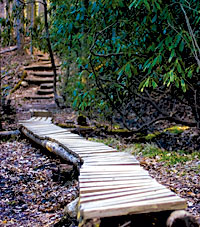Trail construction and maintenance is not what many people imagine: a crew of woodsmen packing an arsenal of chainsaws, dynamite and bulldozers, parting swaths of earth with brute force. Although trailblazing has never been a true art form, it’s rapidly becoming a more complex and elegant process, especially in light of our increasing focus on environmental quality.

Trail-builders are behind-the-scenes workers. We may never see them when we travel their earthen paths, but their planning and vision is always there. They are an eccentric blend, part monk and part engineer. They patiently seek a path of nonresistance, working in harmony with the earth while shaping it into a living sculpture.
Woody Keen is president of the Professional Trailbuilders Association and a part-owner of Trail Dynamics, a trail contractor located in Cedar Mountain. Many locals know him as the mastermind behind the Green’s Lick Trail at Bent Creek.
Keen says that “part of the reason so many trails in our area are problematic is because they are not purpose-built.” Sustainability was not the goal when these trails were built; many were old logging routes where timber extraction was the primary objective. They deteriorate over time, eventually leading to a negative impact on the surrounding environment.
The first step in building a good trail is to create a master plan, Keen says. Ideally, it will answer several questions: Who will be using the trail? How long will the trail be? What kind of experience are users looking for?
Consider Dupont State Forest. Most visitors to the site are on a “destination hike” to see a waterfall and, on their return, care only about getting back to their vehicles. In their rush to get back, they tend to cut across switchbacks, so a wise trail-builder would not stack switchbacks, but rather reduce their numbers in anticipation of these hikers’ tendencies. Conversely, long-distance hikers, who tend to be motivated by “the journey,” would likely find more switchbacks on the trails they use. Knowing your users is vital; when the U.S. Forest Service contracted with Keen to build the Green’s Lick Trail, he took note of the fact that it would see very little use from hikers. Instead, 90 percent of its users would be mountain bikers, whose sport places different demands on a trail.
Water is the main enemy of any trail, and trail design must always consider its flow patterns. Since water flows downhill and tends to seek a straight line, Keen explains that the best trails meander with an up-down rhythm. And techniques for controlling water continue to evolve. As recently as 10 years ago, it was commonplace to install waterbars—wood structures used to direct water off a trail. New water-management methods tend to rely instead on a trail’s contours, incorporating out-sloping and rolling grade dips.
Lee Reading, director of outdoor programs at the Biltmore Estate, says longevity is a primary concern when the estate plans a trail. Keen has built trails on the estate grounds before, and Lloyd Smith, manager of the Explore Biltmore Estate program, says his designs give “world-class results,” citing “grade reversal”—sculpting humps into trails as an effective water-shedder—as one of the most impressive designs there.
Donnie Tessneer, the trails supervisor at Chimney Rock Park, says modern trail-building leans heavily on power equipment such as track-hoes and bulldozers. But when it comes to tackling less accessible areas, Tessneer falls back on hand tools that are as old as trail-building itself: shovels, pulaskis, mattocks, digging bars and rakes.
Trail construction is not cheap. Biltmore’s Reading says he thinks in terms of spending $30,000 to $50,000 per mile when considering new trail construction. Hidden costs must be taken into account as well, including signs, bike racks and trailhead parking. Keen says he knew of one park that spent a half-million dollars on one mile of trail because materials had to be airdropped and the steep terrain posed an extraordinary challenge.
The good news is that a properly designed trail is fairly easy to maintain. Controlling plant growth and cleaning up fallen debris are a couple of the ongoing chores involved in the maintenance phase.
But, adds Asheville-area distance runner Mark Lundblad, those chores don’t happen magically. Good trails, Lundblad says, “wouldn’t be possible without trail maintenance by the park service and clubs like the Carolina Mountain Club. I think we all take their work for granted, and I’m very grateful for their services.”
[Jonathan Poston can be reached by visiting www.aoanewsletter.com ]


Before you comment
The comments section is here to provide a platform for civil dialogue on the issues we face together as a local community. Xpress is committed to offering this platform for all voices, but when the tone of the discussion gets nasty or strays off topic, we believe many people choose not to participate. Xpress editors are determined to moderate comments to ensure a constructive interchange is maintained. All comments judged not to be in keeping with the spirit of civil discourse will be removed and repeat violators will be banned. See here for our terms of service. Thank you for being part of this effort to promote respectful discussion.